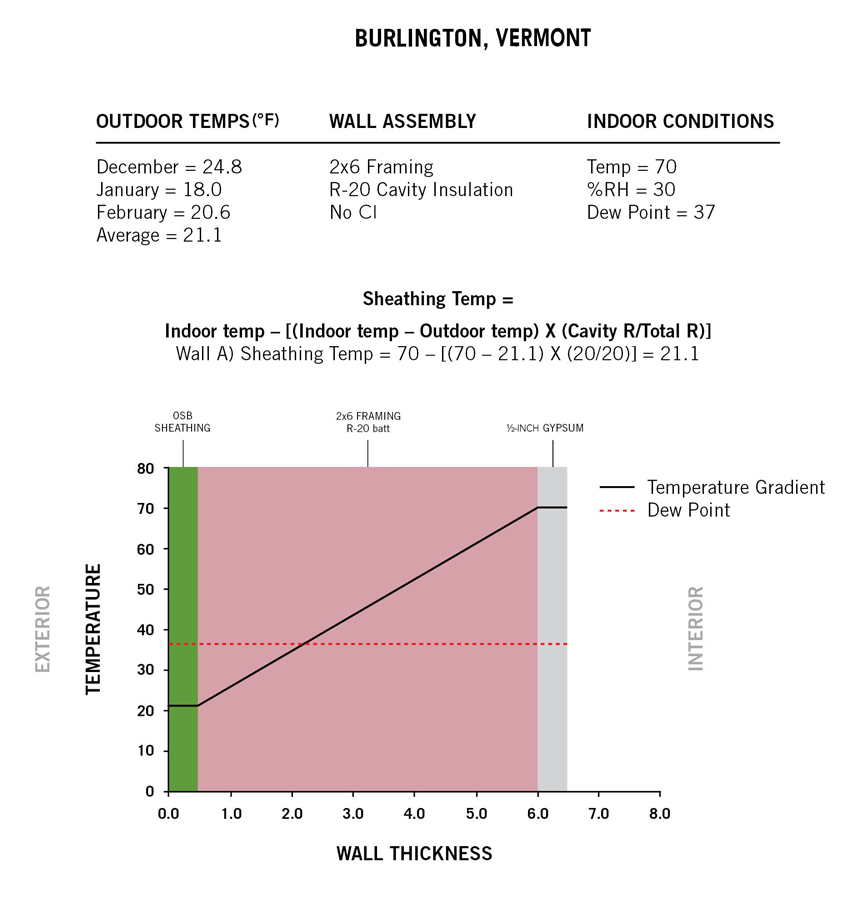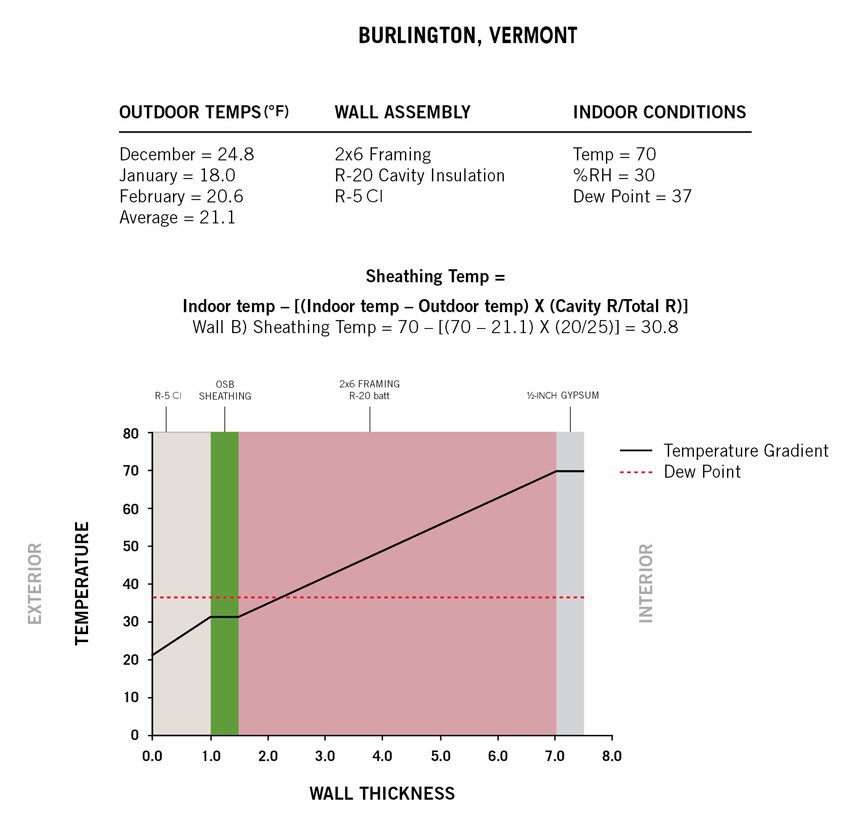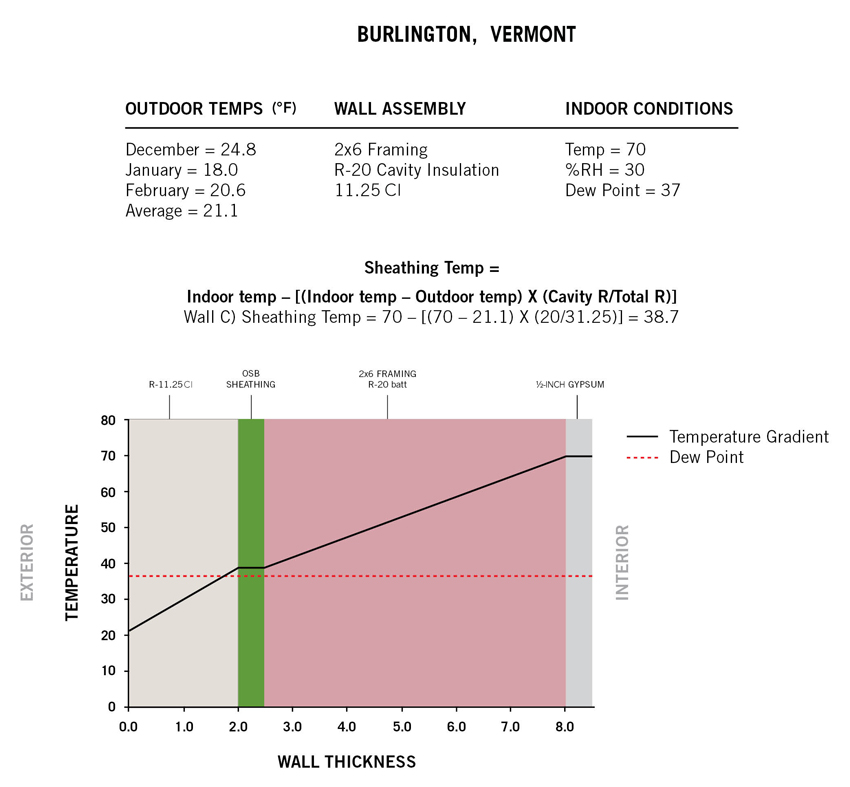Continuous Insulation in Framed Exterior Walls_OLD
Vapor Retarders and Moisture Management
Beyond thermal performance, there is an additional aspect of providing full exterior continuous insulation, particularly in cold climates. As noted, both the IRC and the IBC recognize that insulated walls need an interior vapor retarder to prevent warm, moist air from entering into the wall assembly, condensing, and causing the potential for damage, rot, mold, or other issues. The code classifies vapor retarders based on perm ratings (the lower the perm rating, the less water vapor that passes through the material) as follows. (See Section 1405.3 of the 2015 IBC or Section 702.7 of the IRC with the same language.)
- Class I vapor retarders have a very low perm rating of less than or equal to 0.1 and include materials such as sheet polyethylene or nonperforated aluminum foil and some plastic foam insulation.
- Class II vapor retarders have a moderate perm rating greater than 0.1 but less than or equal to 1 as found in kraft-paper-faced fiberglass batts or certain vapor retarder tested paints.
- Class III vapor retarders have a higher perm rating of greater than 1 but less than or equal to 10 and is common of most latex or enamel paint.
The Building Codes (IBC, IRC) go on to identify where each class of vapor retarder shall and shall not be used by referring, in part, back to the climate zones of the energy code (IECC). The warmer climate zones 1 and 2 shall not have either class I or II vapor retarders installed on the interior (warm) side of framed walls, while climate zones 3 and 4 may not have class I vapor retarders installed. The rationale for these restrictions is that the average climate conditions in zones where it is often significantly hotter and moister on the outside of a building than on the inside would be such that a low perm rate vapor retarder (class I or class II) could trap unwanted moisture in a wall. For the colder climate zones 5, 6, 7, 8, and marine 4, either class I or class II vapor retarders are required because those average climate conditions are more conducive to having water vapor condense into damaging water droplets inside of a framed wall.
All of the above notwithstanding, a significant code exception exists in regard to the use of class I and II vapor retarders in the colder climate zones 5, 6, 7, 8, and marine 4. The presence of plastic foam continuous insulation outside of the studs is acknowledged as altering the conditions for interior vapor retarders as long as an adequate amount of such continuous insulation is used. Both the IRC and the IBC identify the amount of continuous insulation needed to achieve this exception. Specifically, Table 1405.3.2 of the IBC or Table 702.7 in the IRC list the specific R-values for continuous insulation broken out by climate zone 5, 6, 7, 8, and marine 4. The amount of CI varies based on the climate zone and whether 2-by-4 or 2-by-6 framing is used. If the wall design meets the stated criteria, then a class III vapor retarder is called for.
Why does the code make this exception? The reason is once again found in the basic physics of what is happening in the wall. Water vapor in the air is a naturally occurring condition that is measured on the basis of relative humidity (RH). The relationship between the air temperature and the amount of RH determines under what conditions that moisture can condense and turn from its gaseous state to the liquid state of water drops. The point where that happens is called the dew point. The construction concern is that if warm, moist air with a high RH seeps into a cool exterior wall cavity, the dew point might be reached within the wall, causing water droplets to form and accumulate inside the wall. That water could contribute to the growth of mold under warm conditions or could freeze and cause other problems if the wall temperature continues to cool down. This balance between continuous insulation and dew point is the reason that the building codes provide the exception for class I and II vapor retarders in the colder climate zones.
To illustrate this, let’s take an example in climate zone 6 of Burlington, Vermont, where the average outdoor winter temperature is 21.1 degrees Fahrenheit.

In this example showing wall construction in climate zone 6 with only cavity insulation, the temperature of the exterior sheathing is equal to the outdoor temperature and below the dew point during winter months.
Average indoor conditions can be assumed at 70 degrees Fahrenheit with 30 percent relative humidity. Under this scenario, the dew point is calculated to occur at 37 degrees Fahrenheit. The question becomes, where in the wall assembly would we expect the temperature to be at 37 degrees Fahrenheit when the interior surface is at 70 and the exterior is at 21.1 degrees Fahrenheit? The answer will depend on the rate of heat transfer in the wall, meaning it will depend on the amount of insulation used and its location. In a 2-by-6 wood-framed wall with R-20, permeable cavity insulation, and no continuous insulation, the 37-degree-Fahrenheit dew point can be calculated to occur within the cavity insulation. Water will need a surface to condense on so that means the inner face of the exterior sheathing becomes important. We can calculate the surface temperature of that sheathing based on the insulation location and see that, in this case, it will basically be the same as the outdoor temperature of 21.1 degrees Fahrenheit and well below the dew point, allowing condensation and ice to form between the insulation and inside face of the exterior sheathing—hence the need for protection with a class I or II vapor retarder.
By contrast, let’s look at what happens when we add continuous insulation to this wall assembly. If we take all of the same conditions but this time add R-5, low-permeability continuous insulation, we see that we can raise the surface temperature of the sheathing to just under 31 degrees Fahrenheit—a distinct improvement but still below the dew point of 37 degrees Fahrenheit.

In this example showing R-5 continuous insulation, the sheathing temperature is warmer than the outside condition but still below the dew point during winter.
In order to get the sheathing temperature above that mark, we would need to increase the continuous insulation to R-11.25, which would result in a sheathing temperature of 38.7 degrees Fahrenheit or above the dew point.

In this example, increasing the continuous insulation to R-11.25 raises the temperature of the sheathing to be above the dew point, meaning that only a class III interior vapor retarder is required or allowed.
If we look back at Table 1405.3.2 of the IBC or Table 702.7 in the IRC discussed above, we find that the amount of continuous insulation required in climate zone 6 is indeed R-11.25 allowing use of a class III vapor retarder instead of the otherwise required class I or II.
Based on all of the above, it should now be more apparent why section 1405.3.2 states, “Only class III vapor retarders shall be used on the interior side of frame walls where foam plastic insulating sheathing with a perm rating of less than 0.1 is applied…on the exterior side of the frame wall.” In essence, this language is concurring with the science that shows that there is no need, in fact there might be harm, in using a higher-rated class I or class II vapor retarder in walls that have continuous foam insulation. Since most of the foam insulation used for continuous insulation meets the 0.1 perm rate criteria (i.e., class I), the addition of a comparably low interior vapor retarder would run the risk of trapping any moisture between these two surfaces. The moisture management strategy of a wall assembly in this case is to use a higher perm rated class III retarder on the inside, thus allowing for drying toward the interior side of the building.









